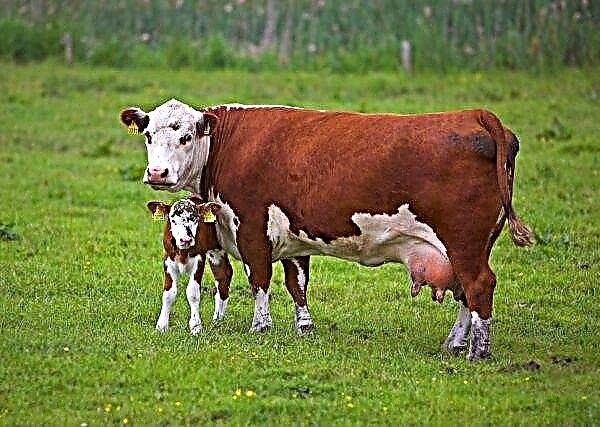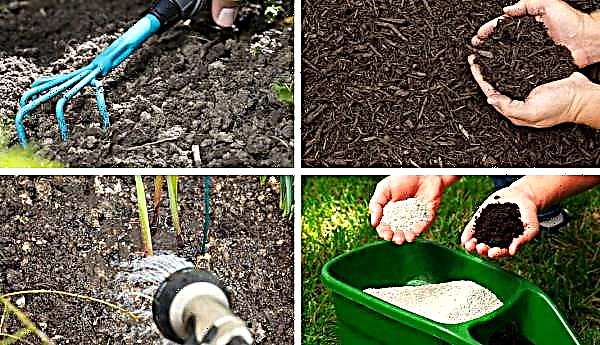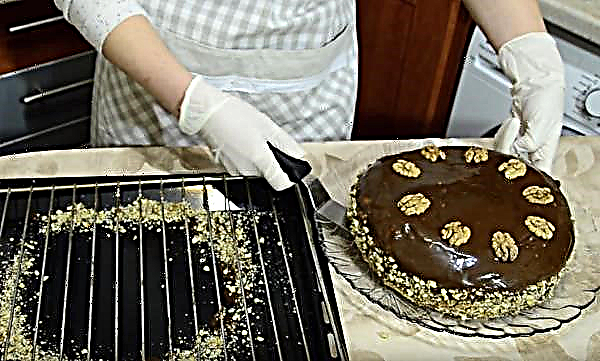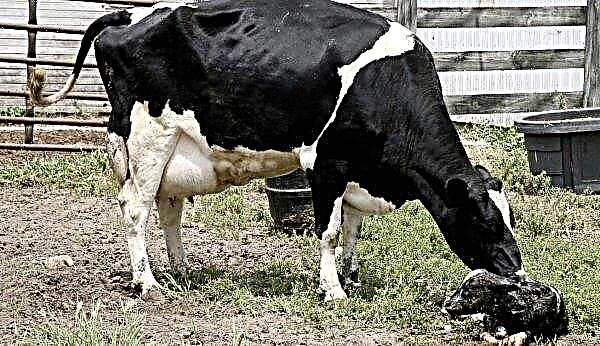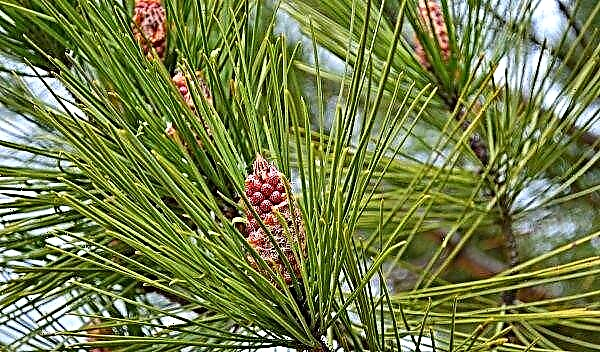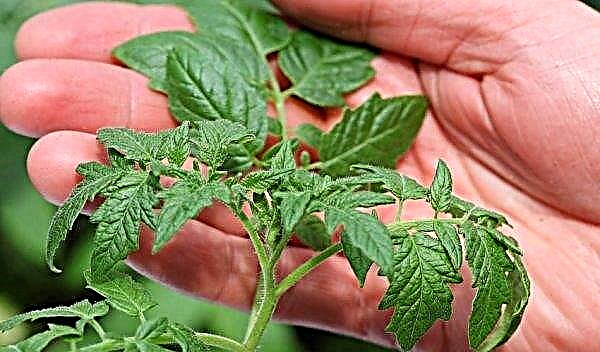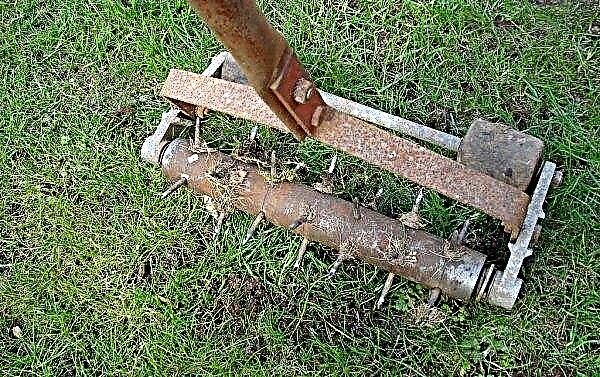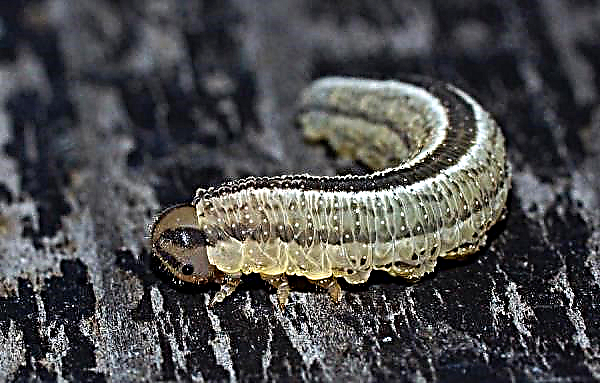One of the recently bred promising varieties of tomatoes is Diabolic F1. These tomatoes are quite unpretentious in care and are characterized by high productivity. The pros and cons of the variety, as well as the features of its cultivation, will be discussed later.
Grade description
The tomato variety Diabolic is characterized by high resistance to drought, most fungal diseases and bacterial rot.
The root system of these plants is massive. The stem is thick, powerful, and stops growing at a height of 120–150 cm. The pinching in the bushes is weak, so no additional work is required to remove the extra shoots. Due to the high growth of the bushes, they need a garter. The foliage of the bushes is weak, leaf blades of green, leathery structure, medium size.
The flowering is plentiful, yellow flowers are collected in inflorescences of 10 pieces. Fruits ripen in 105–115 days from the moment of sowing seeds. The fruiting period is extended and lasts an average of 35 days.Did you know? There are varieties of tomatoes, the ripe fruits of which are painted in green. These include Absinthe, Green Mustang, Lime Green Selet, Green Giant.
The fruits are elliptical in shape. The average mass of the fruit is 110 g. The peel is thin, red in color, not prone to cracking. The pulp has a dense structure, very juicy, dark pink in color. The inside of the fetus is 2–3-cn. Taste is excellent. Commodity yield of fruits is from 75% and above. The use of fruits is universal.
Video: Characterization of tomato variety Diabolik
The yield of these tomatoes, even in adverse weather conditions, subject to all the rules of agricultural technology, is 256–290 c / ha. At the same time, the variety is demanding on high-quality lighting, so when shading, albeit insignificant, crop yield is greatly reduced.
Advantages and disadvantages
Without taking into account the pros and cons of a particular tomato variety, it will be difficult to properly organize work on the site.
- The main advantages of the tomato variety Diabolic F1:
- stable yield under adverse conditions;
- immunity to most fungal diseases and bacterial rot;
- high taste and marketability, which allows the use of products for commercial purposes.
- Among the shortcomings are:
- the need for tying bushes;
- dependence of yield on light source.
Planting and growing tomatoes at home
Diabolic varieties are grown in seedlings. For full development, plants need a well-lit area with low groundwater. Regarding the soil, the plants are undemanding, but the yield will be higher if you take care of its relief and nutritional value in advance. It is also worth monitoring the acidity of the soil. The optimal indicator is 5.5 pH.
Did you know? In 1893, when high customs taxes were imposed on vegetables, the American court recognized the tomatoes as vegetables, despite their botanical affiliation with multi-nested berries, due to the fact that they were served for lunch and not for dessert. The real title of tomato was returned to the European Union only in 2001.
Optimal conditions for growing
Conditions necessary for the normal development of culture:
- temperature - from + 15 ° С;
- soil moisture - 50%;
- air humidity - 70%;
- lighting - plentiful:
- daylight hours - at least 12 hours.
Soil treatment
Soil preparation on the site should begin in the fall, when the entire crop is harvested. First you need to remove all plant debris from the site and cultivate to a depth of 30 cm. After that, the soil must be decontaminated with a 1% solution of copper sulfate or Fitosporin according to the instructions. A week after disinfection, the soil is enriched with nutrients and, if necessary, acidity is reduced.
For every 1 m² you need to make:
- 10 kg of sand;
- 10 kg of manure.
If you want to reduce acidity, you can use dolomite flour (200 g / m²) or wood ash (400 g / m²). When deoxidants are introduced into the soil, compost (10 kg / m²) is used instead of manure. After feeding, the soil is again cultivated to a depth of 20 cm.
In the spring, with the arrival of heat, the soil must again be cultivated and cultivated with Fitosporin, and after a week, 10 kg of compost and dry manure should be added to each 1 m². Then deep cultivation should be carried out again and the soil should be leveled.
Important! "Fitosporin" is a systemic drug that Not only It has a disinfecting effect, but also enriches the soil, and also increases the immunity of plants. It can be used for prevention and treatment at any stage of plant development.
An important nuance of growing tomatoes of this variety is the observance of crop rotation. Plants cannot be planted in the same place for 3 years. The best precursors for tomatoes will be siderata plants and legumes. Do not plant tomatoes after other solanaceous vegetables.
The following soil composition is prepared for seedlings, mixing elements in the same proportions:
- peat;
- sand;
- compost.
The composition is treated with Fitosporin (5 g of powder per 10 l of water) or wood ash is added (20% of the total soil mass). It is also possible to disinfect soil by calcining in an oven at a temperature of + 100 ° C and an open door.
Planting Material Processing
Tomato seeds Diabolic do not require additional processing before planting. Manufacturers have already taken care of this and carried out all the necessary manipulations. Sown seeds dry in disinfected soil.
Sowing technology
Sowing seeds is carried out 30-40 days before planting in open ground in late March - early April in common containers. Before laying the soil in a container, it must be rinsed with a solution of "Furacilin" (1 tablet per 100 ml of boiling water).
Sequencing:
- After processing the container, place a 1 cm thick layer of expanded clay on the bottom, then lay the soil. Soil moisture should be approximately 50-60%.
- Make furrows 1 cm deep and place the seeds in them at a distance of 5 cm from each other.
- Cover the seeds with soil and spray from the spray bottle with warm (+ 30 ° C) water.
- Cover the surface of the container with transparent film or glass.
- Set aside the container in a room where the air temperature is maintained within + 25 ° C.
Before emergence, it is necessary to remove the shelter for 20 minutes every day and check the quality of the soil. If mold appears, remove a thin layer of soil and replace it with sand. If necessary, moisten the soil with a spray bottle.
With the advent of sprouts, remove the shelter and rearrange the container on a well-lit window sill. Gradually lower the air temperature to +18 ... + 20 ° С.
After the appearance of 3 full leaves, you need to pick in separate containers. To completely eliminate the risks of traumatizing plants at the stage of the final dive into the ground, it is better to use peat pots. The mixture at this stage is prepared according to the same principle as before sowing.
Seedlings are also watered as necessary from a spray gun.
Top dressing before transplanting into open ground should be done 3 times:
- With the first 2 leaves - add 1.5 potassium salt + 0.5 g of urea + 4 g of superphosphate to 1 liter of water.
- 10 days after diving into separate containers - add 10 tbsp. To 10 l of water l urea.
- 10 days before the final transfer to a permanent place - Add 1 g of potassium sulfate + 0.6 g of ammonium nitrate + 4 g of superphosphate to 1 liter of water.
Important! At the stages of active vegetation of plants, superphosphates are used only in combination with water. When laid in the soil, the substance decomposes for a very long time and the effect of its action will be minimal.
Preparing for transplanting seedlings
For transplanting into open ground, seedlings need to start to be prepared in 10-14 days. The main task at this stage is to adapt the plants to the conditions of the street climate. For this, the air temperature in the room is gradually reduced to outdoor. At night, the air temperature should be below daytime by 3 ° C.
After lowering the temperature to the optimum value, seedlings are put on an unglazed balcony during the day. The interval of time spent in such conditions should be gradually increased to 12 hours, and plants should be brought into the house at night. Once this stage is completed, you can leave the seedlings on the street and at night. By the time of planting, plants should be free to spend 24 hours outdoors.

Planting seedlings in a permanent place
In open ground, seedlings begin to be planted on May 15. For each 1 m², it is permissible to plant no more than 3 plants due to their size.
The site should be marked out for holes, dig holes with a diameter of 15 cm and a depth of 20 cm, keeping the distance between them 40 cm. Indent 60 cm between the rows. If the seedlings are planted in disposable plastic containers, then the seedlings must be watered abundantly a day before transplanting - this will facilitate the removal of seedlings from glasses. But peat pots are placed directly in the holes. The day before the pick, the plants are also watered, but in moderation.
Before planting, a third of the pit is filled with soil and plants are placed in it. The voids are covered with earth, slightly tamping around the stem. Then watering is carried out, about 300 ml of water per 1 plant. The soil around the stem is mulched with peat or compost.
Features of tomato care
Diabolic F1 tomatoes are not too demanding to care for.
The main agricultural activities carried out after planting in open ground:
- fertilizer application;
- watering;
- garter;
- aeration of the soil.
Fertilizers and fertilizers
In total, tomatoes of this variety after diving into the open ground must be fertilized 3 times:
- 10 days after transplantation;
- with the advent of buds;
- with the advent of ovaries.
At this stage, do not overdo it with fertilizers containing nitrogen - this will provoke a violent growth of greenery and deprive you of the crop. The first time you can use a solution of cow manure. It must be diluted with water in a ratio of 1: 2 and applied 200 ml to each bush.
The second top dressing is carried out using a solution of wood ash: 400 g of the substance should be added to 10 liters of water. This amount of solution is enough to process 1 m² of plantings.
At the third feeding, a yeast solution is used. To prepare it for 50 liters of water, add 2 packs of yeast + 3 tbsp. sugar + 5 kg of fresh green nettle with tops. Insist such a solution should be 1 day, then make 10 l per m².
Watering
Humidification of the soil is carried out as necessary, taking into account weather conditions. Young plants are watered daily in the evening, pouring 800 ml of water on each plant, and adult specimens are moistened every 3-5 days with 3-5 liters.
Important! Watering tomatoes must be completely canceled if the rainy season begins.
The water temperature should be similar to the ambient temperature ± 3 ° C. Watering should prevent moisture from entering the ground, otherwise the risk of rot will increase. The best option is to use a drip irrigation system or channel, when water is supplied directly to the root. The application of root fertilizers is combined with watering. It is important to correctly calculate the flow rate of the fluid consumed by the plant. For example, at the initial stage, when plants need to pour 800 ml of water per day, when feeding manure with a volume of 300 ml of water, 500 ml will need to be added. Fertilizers are applied in the morning, and in the evening they are watered on the same day.
The application of root fertilizers is combined with watering. It is important to correctly calculate the flow rate of the fluid consumed by the plant. For example, at the initial stage, when plants need to pour 800 ml of water per day, when feeding manure with a volume of 300 ml of water, 500 ml will need to be added. Fertilizers are applied in the morning, and in the evening they are watered on the same day.
Stepson
Tomato bushes should be formed in 2 stems. Garter is carried out when the bush reaches a height of 25 cm. For garter it is convenient to use horizontal trellis. For their preparation, along the entire length of the row, it is necessary to drive in several support stakes and pull 2-3 rows of rope between them.
The first rope is pulled at a height of 25 cm from the soil surface. As the branches grow, they must be fixed on the trellis using natural fabric or special clips that can be found in hardware stores.
Soil cultivation and weeding
Loosening of the soil is carried out regularly after each moistening of the soil. Directly next to the plant, the soil should be loosened to a depth of 5 cm, between rows - 10 cm. Along the way, weed should be removed and the bushes examined for the presence of diseases and pests.
Diseases and Pests
The variety is resistant to many fungal diseases and even to bacterial rot. The only disease that often appears when watering rules are not followed is vertebral rot.
There is no full cure for this disease, the only way is prevention, which consists in the following:
- selection of places for planting with water-intensive soils;
- compliance with the irrigation regime;
- maintaining the optimal distance between plants;
- ensuring normal ventilation when growing in greenhouses.
Among the pests dangerous for this variety are:
- Colorado beetle - to eliminate it, the drug "Confidor" is used (dissolve 1 g of the drug in 100 ml of room temperature water and add 1 liter of water);
- aphid - Confidor is also suitable for controlling the parasite.
Important! In the control of pests, the same insecticide cannot be used every time.
Prevention of diseases and pests is high-quality agricultural technology. Most pests and fungal spores winter in the upper layers of the soil, so special attention should be paid to deep cultivation of the soil at the preparatory stages, as well as throughout the growing season.
Harvest Dates
Diabolic tomato harvesting begins in August. Fruits must be picked together with the stalks at the stage of technical maturity as they mature. These tomatoes can be kept fresh for a very long time. For storage, they are placed in wooden low boxes, the bottom of which is covered with straw. Fruits should be laid out in layers at a distance of 1 cm from each other and sprinkled with sawdust. In this condition, the crop must be placed in a dark place where the air temperature is maintained within +5 ... + 10 ° C, and humidity - 70%.
So, the tomato variety Diabolic F1 is attractive due to its high resistance to diseases and stable yield under any conditions. When growing it, you need to remember that in order to increase productivity, it is necessary to provide these tomatoes with good lighting.

